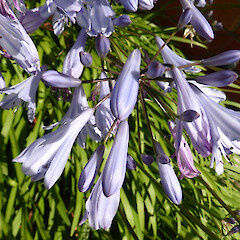Agapanthus praecox subsp. minimus
Common name
dwarf agapanthus
Family
Alliaceae
Flora category
Vascular – Exotic
Structural class
Herbs - Monocots
Conservation status
Not applicable
Brief description
Clump-forming perennial. Strap-like leaves shorter than in subsp. praecox, leathery, arching, arising from base in clumps up to 20, sap watery. Flowers smaller and paler than in subsp. orientalis, in many-flowered umbrella-shaped clusters (Oct)-Dec-March, and it appears to flower over a longer period of the year.
Habitat
Similar to A. praecox subsp. praecox but, to date, much less invasive in NZ. Drought tolerant, best flowering in full sun. Is proving popular with gardeners for its smaller and ‘tidier’ growth habits than subsp. praecox.
Flowering
Dec-March
Flower colours
Blue
Life cycle
Spreads from planted specimens, but as at 2016, rather sparingly
Propagation technique
Clump division; seed
Year naturalised
2010
Origin
South Africa
Reason for introduction
Ornamental
Etymology
agapanthus: From the Greek agape, meaning ‘love’, and anthos, meaning ‘flower’, translating broadly as the flower of love.
minimus: Smallest (rather a misnomer)






